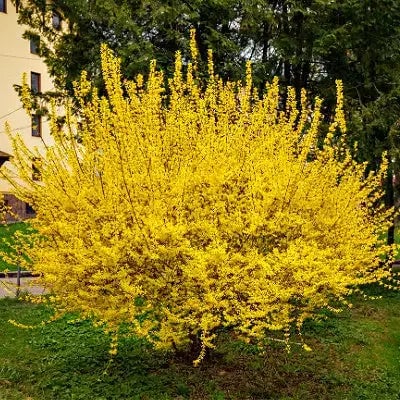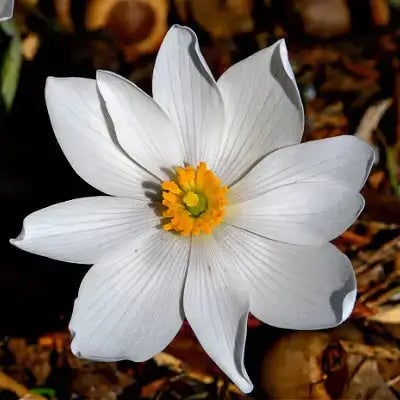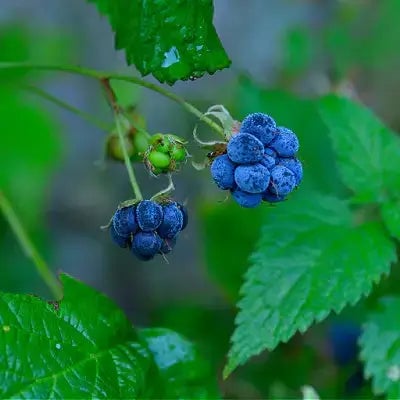Rubus Hispidus, sometimes called the Bristly Dewberry, Hispid Swamp Dewberry, Swamp Dewberry, Bristly Groundberry, or Running Swamp Blackberry, is a wild plant native to the Eastern United States.
This fruit-bearing plant is a hybrid of blackberries and can come in many variations (listed at the bottom of this article).
Songbirds, game birds, and a wide array of fauna rely on this plant for food. During the summer, birds feast on the berries. Year-round, muskrats eat the roots. Also, year-round, moose, elk, whitetail deer, blacktail deer, mule deer, rabbits, hares, squirrels, chipmunks, and even raccoons forage off the stems and leaves of this plant.
Appearance
Bristly Dewberries are herb-like shrubs that crawl outwards along the ground rather than up like their blackberry relatives.
These plants produce bright and glossy, green three-parted leaves. The leaves are shiny and pale green, while immature but slowly darken and dull as they age.
Rubus Hispidus produces beautiful white five-petaled flowers in loose, terminal clusters.
Rubus Hispidus produces red or black fruits, sour or even bitter. The berries are similar to blackberries, though they look like smaller, slightly immature blackberries, even when they are fully mature and finished growing.
Dewberry stems are covered in backward-curved bristles. There are a couple of hundred follicles inside every square centimeter on the branch. The needle-like bristles attach the plant to the ground and groundcover as they spread and travel along the forest floor.
Dewberries never get more than a few inches tall.
Seasons
Rubus Hispidus is a perennial.
This plant will flower and produce berries from June until September.
Native Areas
Rubus Hispidus is a native to the Americas but also grows wild worldwide. Rubus Hispidus can be located in the following states within the US:
- Connecticut
- Delaware
- Iowa
- Illinois
- Indiana
- Kentucky
- Massachusetts
- Maryland
- Maine
- Michigan
- North Carolina
- New Hampshire
- New Jersey
- New York
- Ohio
- Pennsylvania
- Rhode Island
- South Carolina
- Tennessee
- Virginia
- Vermont
- Wisconsin
- West Virginia
Quick Facts
USDA Zones 3-8.
Dewberry: Rubus Hispidus prefers dappled sunshine but can survive in full sun to full shade. It can only tolerate direct sunlight for 3 to 4 hours a day when planted in full sun.
This plant prefers moist, usually lower elevation (less than 3,200 feet) habitats where a lot of water is regularly available.
They need moderately wet and acidic soil to thrive truly.
Dewberries are safe to eat. Use them to create delicious jams, jellies, or preserves-- make sure you add enough sugar to counteract their naturally sour flavors.
Similar Varieties of the Rubus Hispidus
While Rubus Hispidus is a blackberry hybrid, it has produced other mixed mixes that vary slightly. New combinations are still being discovered too.
Bristly Dewberries are herb-like shrubs that crawl outwards along the ground rather than up like their blackberry relatives.These plants produce bright and glossy, green three-parted leaves. The leaves are shiny and pale green, while immature but slowly darken and dull as they age. Rubus Hispidus produces beautiful white five-petaled flowers in loose, terminal clusters.Rubus Hispidus produces red or black fruits, sour or even bitter. The berries are similar to blackberries, though they look like smaller, slightly immature blackberries, even when they are fully mature and finished growing.
How to Utilize Dewberry Plants
Dewberry plants (Rubus spp.) Dewberry plants from Rubus spp. Share a close familial link with blackberries and raspberries while being celebrated for their delicious fruits and resilient growth. The sprawling vines of dewberry plants creep across forest edges, fields, and roadsides, yielding small clusters of berries transitioning from red to dark purple when ripe. The dewberry plant serves as more than just a source of nutritious snacks since it provides multiple benefits for cooking recipes, herbal treatments, and garden projects. Master dewberries' identification and harvesting methods to fully utilize their resilient characteristics.
The first crucial step is to learn how to recognize dewberry plants properly. Dewberry canes share their thorny structure with blackberries but tend to sprawl across the ground instead of standing upright. The leaves of dewberry plants exhibit three to five lobes, which display light serrations and pale undersides. Dewberries transition from green to red and then to deep purple-black as they ripen during late spring or early summer. These berries deliver a sweetness that surpasses that of blackberries, making them perfect for both fresh consumption and culinary uses.
A wide range of recipes allows dewberries to stand out in the kitchen. A fundamental way to consume fresh berries involves adding them to salads or adding them as a topping for your morning cereal. The sweet-tart taste of these berries combines well with yogurt and pancakes and is also delicious when served with ice cream. Dewberry jam and jelly remain popular because the berries' natural high pectin content leads to excellent gelling results. To enjoy a luxurious dessert experience, bake dewberries in a delicious cobbler or pie. With a touch of sugar and citrus zest, these berries transform into a luscious filling that offers an ideal mix of sweet and tangy flavors.
Traditional medicine acknowledges the beneficial properties of dewberry plants, which extend beyond their culinary uses. People use the leaves and roots to create herbal teas, which help with inflammation relief and digestion assistance while soothing sore throats. Scientific studies on the health benefits of dewberry products are minimal, yet herbalists continue to favor herbal teas and tinctures for their possible health-supportive effects. Anyone considering dewberry preparations for treating ailments should seek advice from a healthcare professional because herbal remedies require careful use.
Planting dewberry in your garden rewards people who want their harvest. Dewberries require well-drained soil and thrive in areas with partial to full sun exposure. Growing as groundcover dewberries provide an appealing visual due to their spreading growth pattern but require vigilant management to prevent them from becoming invasive plants. Pruning helps maintain vine health while promoting improved berry production. Wear gloves to keep your hands safe from thorns and eliminate dead or damaged canes yearly.
Dewberry vines possess multiple functional applications that extend beyond culinary purposes. Dried dewberry stalks can be used to weave small baskets or wreaths. The trailing stems of these plants create suitable wildlife habitats by offering shelter while serving as a food source for small animals.
Dewberry plants demonstrate flexibility and usefulness across various uses. The combination of dewberry's distinctive taste and strong growth qualities makes it beneficial for anyone planning to harvest its berries for pastries or herbal tea or introducing it as a garden groundcover. By exploring the humble dewberry plant, you will discover its many uses, which make it valuable for culinary recipes, medical applications, and gardening tasks.
Read more

The Goldilocks forsythia, also known as Gold Curl or Courtacour forsythia, is a genetic mutation of the Spring Glory Forsythia created at the Institut National De La Recherche Agronomique in Angers...

Bloodroot plants are perennial and native to regions of North Eastern America. They were initially wildflowers that grew in the woods and forests.


